2004 CHEVROLET VENTURE change wheel
[x] Cancel search: change wheelPage 350 of 516
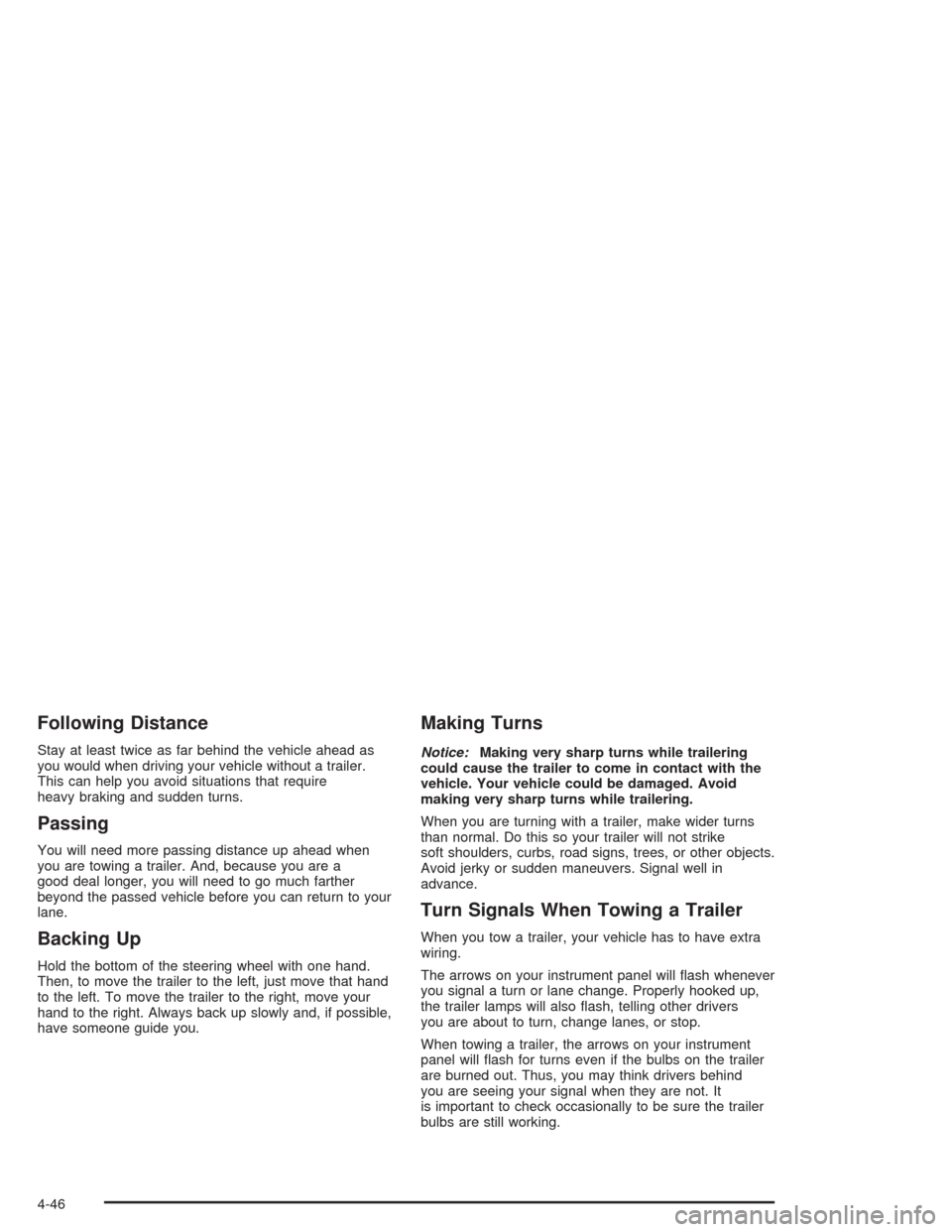
Following Distance
Stay at least twice as far behind the vehicle ahead as
you would when driving your vehicle without a trailer.
This can help you avoid situations that require
heavy braking and sudden turns.
Passing
You will need more passing distance up ahead when
you are towing a trailer. And, because you are a
good deal longer, you will need to go much farther
beyond the passed vehicle before you can return to your
lane.
Backing Up
Hold the bottom of the steering wheel with one hand.
Then, to move the trailer to the left, just move that hand
to the left. To move the trailer to the right, move your
hand to the right. Always back up slowly and, if possible,
have someone guide you.
Making Turns
Notice:Making very sharp turns while trailering
could cause the trailer to come in contact with the
vehicle. Your vehicle could be damaged. Avoid
making very sharp turns while trailering.
When you are turning with a trailer, make wider turns
than normal. Do this so your trailer will not strike
soft shoulders, curbs, road signs, trees, or other objects.
Avoid jerky or sudden maneuvers. Signal well in
advance.
Turn Signals When Towing a Trailer
When you tow a trailer, your vehicle has to have extra
wiring.
The arrows on your instrument panel will �ash whenever
you signal a turn or lane change. Properly hooked up,
the trailer lamps will also �ash, telling other drivers
you are about to turn, change lanes, or stop.
When towing a trailer, the arrows on your instrument
panel will �ash for turns even if the bulbs on the trailer
are burned out. Thus, you may think drivers behind
you are seeing your signal when they are not. It
is important to check occasionally to be sure the trailer
bulbs are still working.
4-46
Page 422 of 516
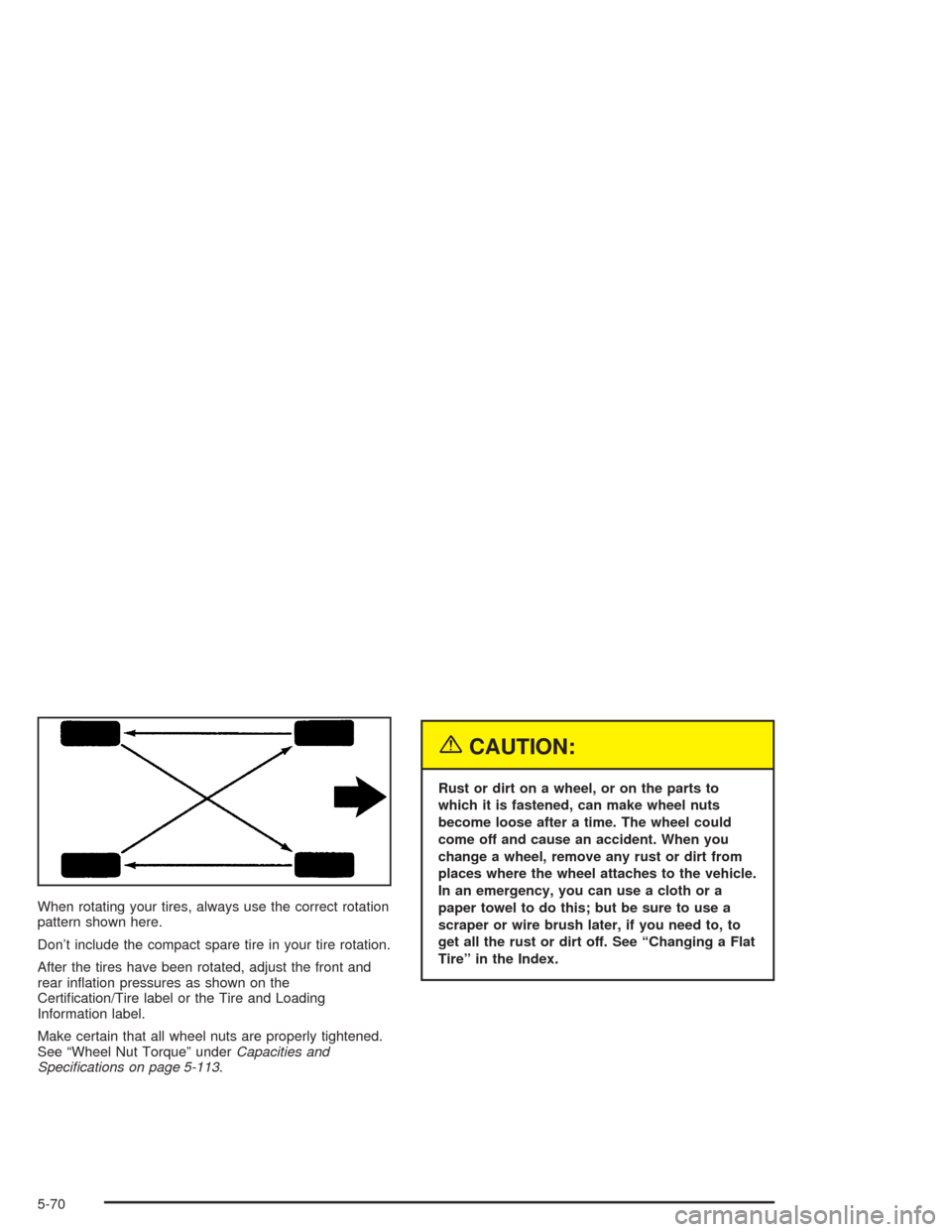
When rotating your tires, always use the correct rotation
pattern shown here.
Don’t include the compact spare tire in your tire rotation.
After the tires have been rotated, adjust the front and
rear in�ation pressures as shown on the
Certi�cation/Tire label or the Tire and Loading
Information label.
Make certain that all wheel nuts are properly tightened.
See “Wheel Nut Torque” underCapacities and
Speci�cations on page 5-113.
{CAUTION:
Rust or dirt on a wheel, or on the parts to
which it is fastened, can make wheel nuts
become loose after a time. The wheel could
come off and cause an accident. When you
change a wheel, remove any rust or dirt from
places where the wheel attaches to the vehicle.
In an emergency, you can use a cloth or a
paper towel to do this; but be sure to use a
scraper or wire brush later, if you need to, to
get all the rust or dirt off. See “Changing a Flat
Tire” in the Index.
5-70
Page 430 of 516

If a Tire Goes Flat
It’s unusual for a tire to “blowout” while you’re driving,
especially if you maintain your tires properly. If air goes
out of a tire, it’s much more likely to leak out slowly.
But if you should ever have a “blowout,” here are a few
tips about what to expect and what to do:
If a front tire fails, the �at tire will create a drag that
pulls the vehicle toward that side. Take your foot off the
accelerator pedal and grip the steering wheel �rmly.
Steer to maintain lane position, and then gently brake to
a stop well out of the traffic lane.
A rear blowout, particularly on a curve, acts much like a
skid and may require the same correction you’d use
in a skid. In any rear blowout, remove your foot from the
accelerator pedal. Get the vehicle under control by
steering the way you want the vehicle to go. It may be
very bumpy and noisy, but you can still steer. Gently
brake to a stop, well off the road if possible.{CAUTION:
Lifting a vehicle and getting under it to do
maintenance or repairs is dangerous without
the appropriate safety equipment and training.
The jack provided with your vehicle is
designed only for changing a �at tire. If it is
used for anything else, you or others could be
badly injured or killed if the vehicle slips off
the jack. Use the jack provided with your
vehicle only for changing a �at tire.
If a tire goes �at, the next part shows how to use your
jacking equipment to change a �at tire safely.
Changing a Flat Tire
If a tire goes �at, avoid further tire and wheel damage
by driving slowly to a level place. Turn on your
hazard warning �ashers.
5-78
Page 440 of 516
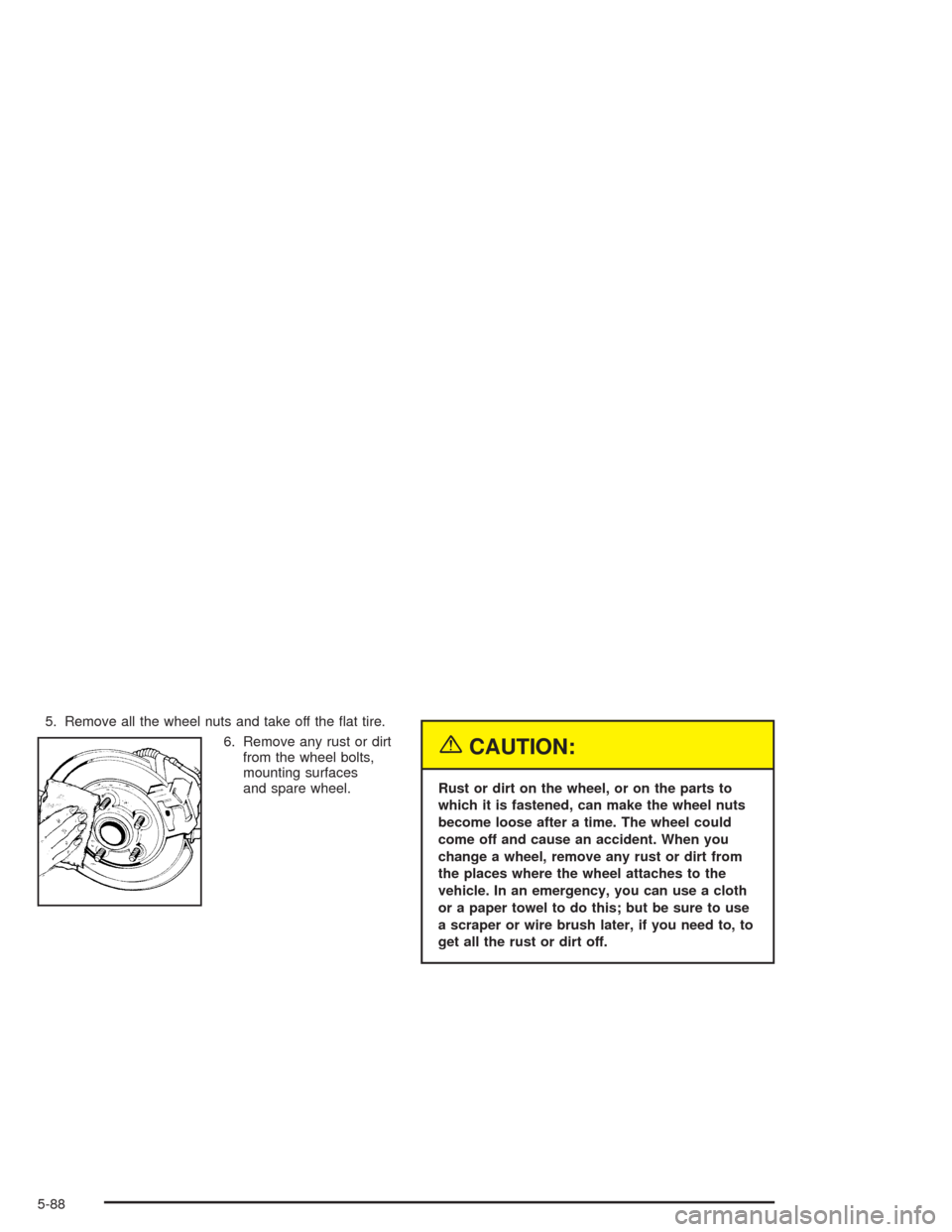
5. Remove all the wheel nuts and take off the �at tire.
6. Remove any rust or dirt
from the wheel bolts,
mounting surfaces
and spare wheel.
{CAUTION:
Rust or dirt on the wheel, or on the parts to
which it is fastened, can make the wheel nuts
become loose after a time. The wheel could
come off and cause an accident. When you
change a wheel, remove any rust or dirt from
the places where the wheel attaches to the
vehicle. In an emergency, you can use a cloth
or a paper towel to do this; but be sure to use
a scraper or wire brush later, if you need to, to
get all the rust or dirt off.
5-88
Page 501 of 516
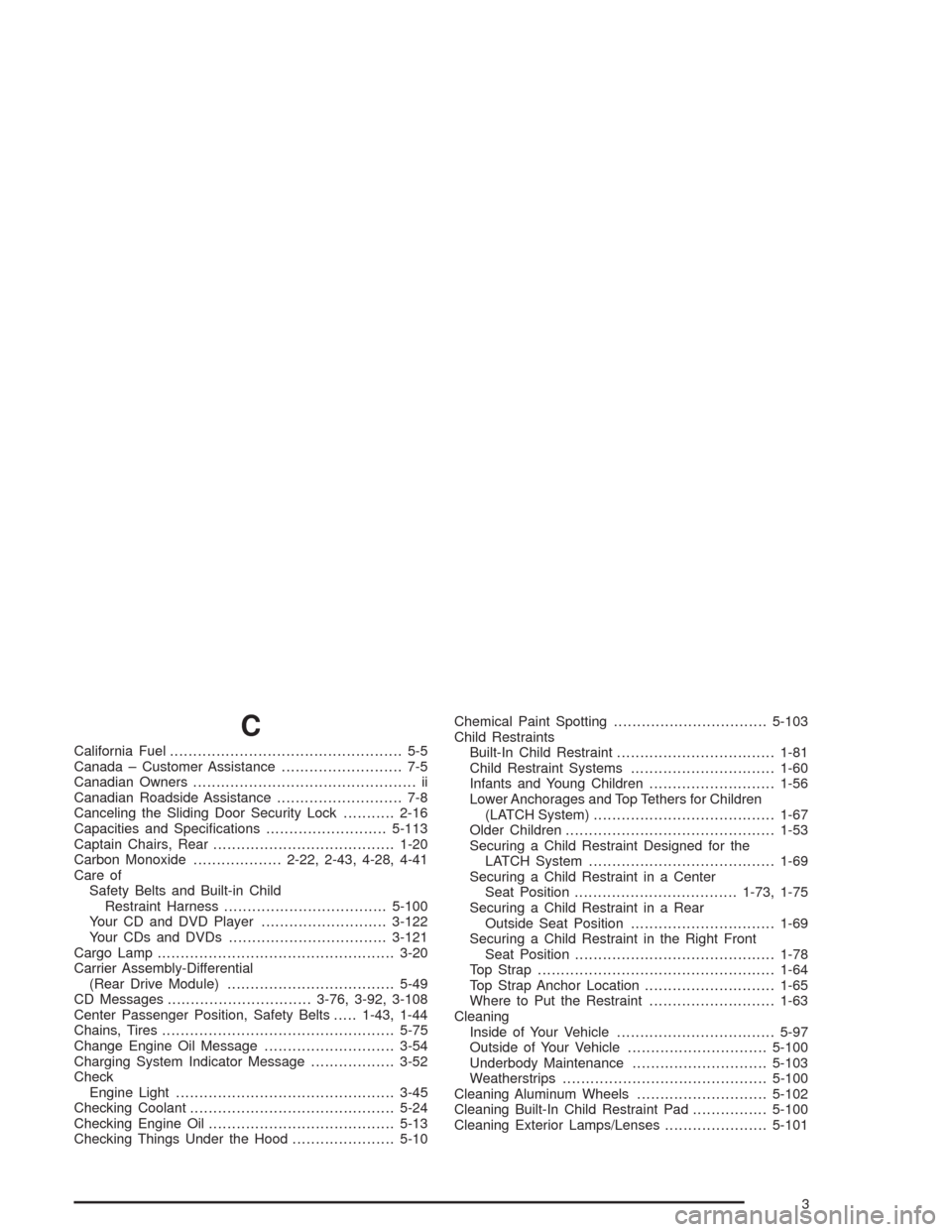
C
California Fuel.................................................. 5-5
Canada – Customer Assistance.......................... 7-5
Canadian Owners................................................ ii
Canadian Roadside Assistance........................... 7-8
Canceling the Sliding Door Security Lock...........2-16
Capacities and Speci�cations..........................5-113
Captain Chairs, Rear.......................................1-20
Carbon Monoxide...................2-22, 2-43, 4-28, 4-41
Care of
Safety Belts and Built-in Child
Restraint Harness...................................5-100
Your CD and DVD Player...........................3-122
Your CDs and DVDs..................................3-121
Cargo Lamp...................................................3-20
Carrier Assembly-Differential
(Rear Drive Module)....................................5-49
CD Messages...............................3-76, 3-92, 3-108
Center Passenger Position, Safety Belts.....1-43, 1-44
Chains, Tires..................................................5-75
Change Engine Oil Message............................3-54
Charging System Indicator Message..................3-52
Check
Engine Light...............................................3-45
Checking Coolant............................................5-24
Checking Engine Oil........................................5-13
Checking Things Under the Hood......................5-10Chemical Paint Spotting.................................5-103
Child Restraints
Built-In Child Restraint..................................1-81
Child Restraint Systems...............................1-60
Infants and Young Children...........................1-56
Lower Anchorages and Top Tethers for Children
(LATCH System).......................................1-67
Older Children.............................................1-53
Securing a Child Restraint Designed for the
LATCH System........................................1-69
Securing a Child Restraint in a Center
Seat Position...................................1-73, 1-75
Securing a Child Restraint in a Rear
Outside Seat Position...............................1-69
Securing a Child Restraint in the Right Front
Seat Position...........................................1-78
Top Strap...................................................1-64
Top Strap Anchor Location............................1-65
Where to Put the Restraint...........................1-63
Cleaning
Inside of Your Vehicle..................................5-97
Outside of Your Vehicle..............................5-100
Underbody Maintenance.............................5-103
Weatherstrips............................................5-100
Cleaning Aluminum Wheels............................5-102
Cleaning Built-In Child Restraint Pad................5-100
Cleaning Exterior Lamps/Lenses......................5-101
3
Page 508 of 516
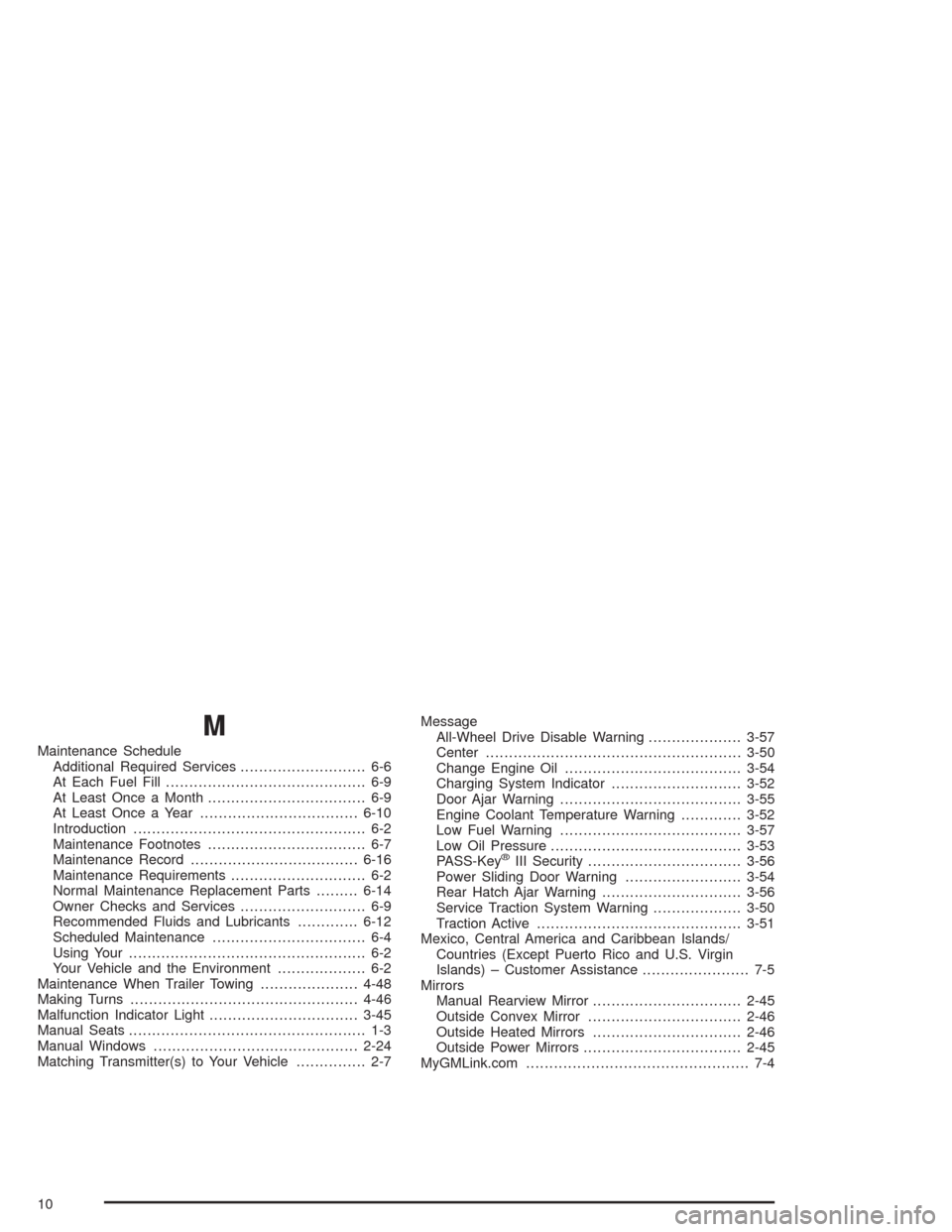
M
Maintenance Schedule
Additional Required Services........................... 6-6
At Each Fuel Fill........................................... 6-9
At Least Once a Month.................................. 6-9
At Least Once a Year..................................6-10
Introduction.................................................. 6-2
Maintenance Footnotes.................................. 6-7
Maintenance Record....................................6-16
Maintenance Requirements............................. 6-2
Normal Maintenance Replacement Parts.........6-14
Owner Checks and Services........................... 6-9
Recommended Fluids and Lubricants.............6-12
Scheduled Maintenance................................. 6-4
Using Your................................................... 6-2
Your Vehicle and the Environment................... 6-2
Maintenance When Trailer Towing.....................4-48
Making Turns.................................................4-46
Malfunction Indicator Light................................3-45
Manual Seats................................................... 1-3
Manual Windows............................................2-24
Matching Transmitter(s) to Your Vehicle............... 2-7Message
All-Wheel Drive Disable Warning....................3-57
Center.......................................................3-50
Change Engine Oil......................................3-54
Charging System Indicator............................3-52
Door Ajar Warning.......................................3-55
Engine Coolant Temperature Warning.............3-52
Low Fuel Warning.......................................3-57
Low Oil Pressure.........................................3-53
PASS-Key
®III Security.................................3-56
Power Sliding Door Warning.........................3-54
Rear Hatch Ajar Warning..............................3-56
Service Traction System Warning...................3-50
Traction Active............................................3-51
Mexico, Central America and Caribbean Islands/
Countries (Except Puerto Rico and U.S. Virgin
Islands) – Customer Assistance....................... 7-5
Mirrors
Manual Rearview Mirror................................2-45
Outside Convex Mirror.................................2-46
Outside Heated Mirrors................................2-46
Outside Power Mirrors..................................2-45
MyGMLink.com................................................ 7-4
10
Page 515 of 516

Trailer Brakes.................................................4-44
Trailer Wiring Harness.....................................4-48
Transaxle
Fluid, Automatic...........................................5-20
Transaxle Operation, Automatic.........................2-36
Transfer Case (Power Transfer Unit)..................5-48
Transmission, Transaxle, Transfer Case Unit
Repair Manual............................................7-13
Transportation Options...................................... 7-8
Trip Computer................................................3-60
Turn and Lane-Change Signals.......................... 3-8
Turn Signal/Multifunction Lever........................... 3-8
Turn Signals When Towing a Trailer..................4-46
U
Ultrasonic Rear Parking Assist (URPA)...............3-22
Underhood Fuse Block...................................5-109
Understanding Radio Reception.......................3-121
Uniform Tire Quality Grading............................5-72
United States – Customer Assistance.................. 7-5
Used Replacement Wheels..............................5-75
Using an MP3 CD..........................................3-88
Using Cleaner on Fabric..................................5-98
Using HomeLink
®...........................................2-51
Using Song List Mode...................................3-106
V
Vehicle
Control........................................................ 4-6
Damage Warnings........................................... iv
Loading......................................................4-35
Symbols......................................................... iv
Vehicle Data Collection and Event Data
Recorders..................................................7-10
Vehicle Identi�cation
Number (VIN)............................................5-104
Service Parts Identi�cation Label..................5-105
Vehicle Personalization....................................2-62
Arming and Disarming the Content
Theft-Deterrent System.............................2-69
Automatic Door Locks..................................2-64
Content Theft-Deterrent System.....................2-68
Delayed Illumination and Exit Lighting.............2-63
Entering Programming Mode.........................2-62
Exiting Programming Mode...........................2-71
Last Door Locking and Lockout Deterrent........2-65
Remote Driver Unlock Control.......................2-66
Remote Lock and Unlock Con�rmation...........2-67
Vehicle Storage..............................................5-42
Ventilation Adjustment......................................3-29
Video Screen................................................3-111
Visor Vanity Mirror..........................................2-26
Visors...........................................................2-26
17
Page 516 of 516

W
Warm-Up Shift................................................2-38
Warning Lights, Gages and Indicators................3-36
Warnings
Hazard Warning Flashers............................... 3-6
Other Warning Devices.................................. 3-7
Safety and Symbols......................................... iii
Vehicle Damage.............................................. iv
Washing Your Vehicle....................................5-100
Weight of the Trailer........................................4-42
Weight of the Trailer Tongue.............................4-43
What Engine Coolant to Use............................5-23
What Kind of Engine Oil to Use........................5-15
What Power Steering Fluid to Use....................5-37
What to Do with Used Oil................................5-18
What Washer Fluid to Use...............................5-38
Wheels
Alignment and Tire Balance..........................5-74
Replacement...............................................5-74
When to Add Engine Oil..................................5-14
When to Change Engine Oil
(GM Oil Life System)...................................5-17
When to Check..............................................5-69
When to Check and Change Automatic Transaxle
Fluid..........................................................5-20
When to Check Power Steering Fluid................5-37
When to Inspect the Engine Air Cleaner/Filter.....5-18When You Are Ready to Leave After Parking
on a Hill.....................................................4-48
Where to Put the Restraint...............................1-63
Why Safety Belts Work....................................1-28
Windows.......................................................2-24
Manual......................................................2-24
Power........................................................2-25
Power Rear Quarter.....................................2-26
Side Window Latches...................................2-25
Windshield Washer.........................................3-10
Fluid..........................................................5-38
Windshield Wiper
Blade Replacement......................................5-56
Fuses......................................................5-106
Windshield Wipers..........................................3-10
Winter Driving................................................4-28
X
XM™ Satellite Radio Antenna System..............3-122
XM™ Satellite Radio Service..........................3-121
XM™ Satellite Radio Service
(48 Contiguous US States)...........3-65, 3-77, 3-93
Y
Your Vehicle and the Environment....................... 6-2
18